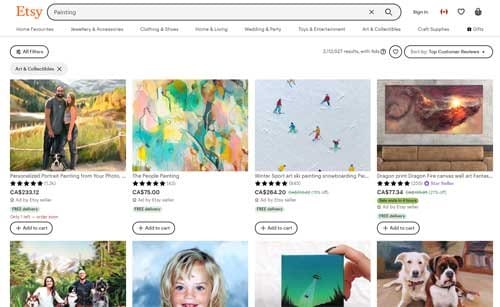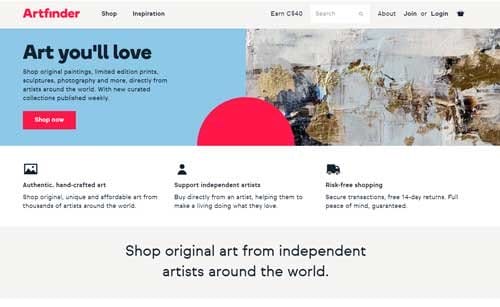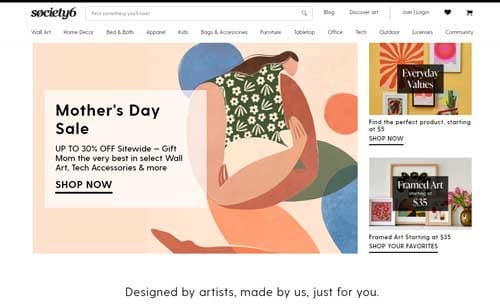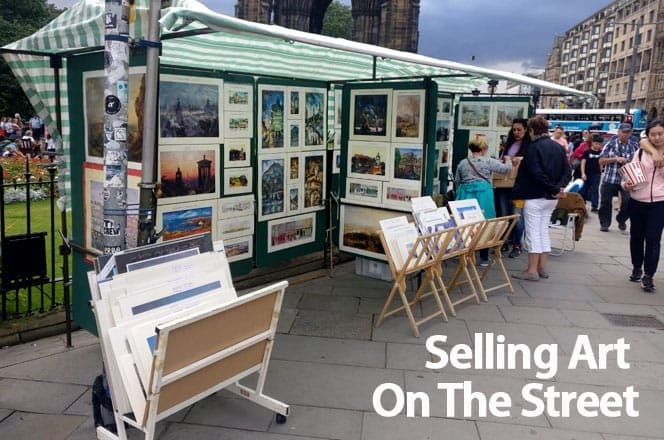The importance of understanding the business side of art cannot be overstated. As an artist, you may be passionate about creating unique and meaningful pieces, but knowing how to sell your art effectively, can be the difference between success and failure in the competitive art world. This article aims to help artists navigate the art market and find success by providing comprehensive and practical advice on various aspects of selling artwork.

The art market is complex and ever-changing, making it essential for artists to understand the business side of their craft. By developing effective sales strategies and learning to adapt to market trends, artists can build sustainable careers while sharing their work with a wider audience. In this guide, we’ll explore various aspects of selling art, from pricing and valuation to online sales channels, in-person sales, and more.
Pricing Art for Success

Understanding how to price and value your artwork is a key aspect of succeeding in the art world. Accurate pricing not only helps you earn a fair income from your work, but it also plays a significant role in attracting collectors and building a sustainable career.
In this section, we’ll discuss the factors you need to consider when pricing your work and provide some strategies to help you navigate this often complex process.
Researching the market
Before you start pricing your artwork, it’s important to research the market and understand the prices other artists are charging for similar works. Investigate artists with comparable styles, mediums, and levels of experience, and take note of their pricing structures. This will give you a better understanding of how your work might fit into the current art market.
Some helpful resources for researching the market include:
- Artsy: An online platform featuring galleries, artists, and their works, with pricing information on many pieces.
- ArtPrice: A comprehensive database of auction results and market trends to help you understand historical pricing for various artists and styles.
Assessing your skill level and artistic achievements
Your skill level and artistic achievements are factors to consider when determining the value of your work. Have you received any awards, participated in prestigious exhibitions, or studied at a well-known art school? These factors can increase the perceived value of your work, allowing you to charge higher prices.
Factors to consider when pricing your work
There are several factors you should consider when pricing your artwork, including:
- Size: Larger artworks often command higher prices due to the increased amount of materials and labor involved.
- Medium: Some mediums, such as oil paint or bronze, may be more expensive to work with, and this cost should be factored into your pricing.
- Edition: Limited edition prints or sculptures can be more valuable than open editions, as they are perceived as more exclusive and collectible.
- Framing: If you’re selling framed works, be sure to include the cost of framing in your pricing.
Read more: How to Price Your Art
Pricing strategies for different types of artwork
Depending on the type of artwork you create, you may need to adopt different pricing strategies. Here are some suggestions for various art forms:
- Original paintings and drawings: Price your work based on size, medium, and your level of experience. A common method is to charge per square inch or centimeter.
- Prints: If you’re selling limited edition prints, consider pricing them higher than open editions. You can also use tiered pricing, where the price increases as fewer prints remain in the edition.
- Sculptures: Consider the cost of materials, the complexity of the piece, and the time it took to create when pricing sculptures.
The importance of consistency in pricing
Consistency is important when pricing your artwork, as it helps build trust with collectors and prevents confusion. Avoid drastically varying your prices based on factors like where the artwork is being sold or the buyer’s perceived wealth. Stick to a consistent pricing structure and adjust your prices only when necessary, such as when your skill level or market demand changes.
Adjusting prices based on market trends and demand
As an artist, you’ll need to be aware of market trends and how they may affect your pricing. If demand for your work increases, you may be able to raise your prices. Conversely, if you’re struggling to sell your work, consider lowering your prices or offering discounts to encourage sales. Keep an eye on the overall art market, as well as trends within your specific niche, and adjust your pricing strategy accordingly.
TIP: Periodically reassess and reevaluate your pricing. As your career progresses and you gain more experience, your artwork may appreciate in value. Regularly reviewing your pricing, perhaps annually or bi-annually, can help you ensure that your artwork is priced appropriately based on your current standing in the art world and the demand for your work. This will not only help you stay competitive in the market but also reflect the true worth of your art as you evolve as an artist.
Online Sales Channels

In today’s digital age, selling art online has become increasingly popular and important for artists. With a variety of online platforms available, you can showcase your work to a global audience and expand your reach beyond local galleries and exhibitions.
In this section, we’ll discuss how to sell your art through your website, online marketplaces, and galleries, as well as the benefits and drawbacks of various platforms.
Selling Art Through Your Website
Creating your own website is a fantastic way to showcase your portfolio, share your artistic journey, and sell your artwork directly to collectors. A well-designed website can help you establish a professional online presence, making it easier for potential buyers to find and purchase your art.
To sell art through your website, consider using e-commerce platforms like Shopify or Wix, which offer user-friendly tools for setting up an online store. These platforms also allow you to integrate payment processing, making it easy for customers to purchase your work securely.
TIP: Optimize your online presence for search engines. Implementing Search Engine Optimization (SEO) techniques on your website and online profiles can help increase your visibility on search engines like Google, making it easier for potential buyers to discover your artwork. To optimize your online presence, consider the following:
- Use relevant keywords: Incorporate keywords related to your artwork, niche, and target audience in your website content, image descriptions, and meta tags.
- Create high-quality content: Publish engaging and informative blog posts or articles about your art, your creative process, or industry trends. This can help boost your search engine rankings and attract more visitors to your site.
- Build quality backlinks: Reach out to reputable art blogs, websites, or online publications to feature your work or contribute guest articles, which can result in valuable backlinks to your website and improve your search rankings.
Utilizing online marketplaces and galleries
In addition to your website, you can also take advantage of online marketplaces and galleries to sell your artwork. These platforms allow you to reach a broader audience and can provide additional exposure for your work.
Overview of popular online platforms
There are several popular online platforms for selling art, each with its own unique features and benefits. Some of the most well-known platforms include:

A popular marketplace for artwork, Etsy boasts a welcoming community and an intuitive interface, making it an excellent choice for artists venturing into online sales. Although the platform’s accessible design and encouraging community are attractive features, it also comes with intense competition. Therefore, you may need to allocate resources to marketing efforts in order to differentiate yourself from others.
Read more here about Selling Art on Etsy.

A leading online art gallery that features a curated selection of artworks from around the world. Saatchi Art offers a more sophisticated platform for selling original art and limited edition prints. This platform’s curated selection and professional presentation can help you reach a more discerning audience, but the commission fees can be higher than other platforms.

An online marketplace that connects artists with art lovers, Artfinder focuses on making it easy for buyers to discover and purchase original art. It offers a user-friendly platform and a wide range of price points, but the competition can be intense, and you may need to put effort into promoting your work to stand out.

This platform allows artists to sell their artwork on a variety of products, such as prints, phone cases, and home decor items. Society6 is a great option for artists looking to expand their revenue streams through merchandise. The downside is that the royalties on product sales you make may be lower than what you could earn from selling original art or limited edition prints.
To increase your chances of success when selling art online, consider the following tips:

- Write compelling descriptions: Craft engaging and informative descriptions that capture the attention of potential buyers. Begin by highlighting the unique aspects of each piece, such as the colors, textures, and materials used. By providing context and insight into your artistic journey, you create a narrative that not only educates but also captivates your audience, increasing the likelihood of a sale and fostering a lasting connection with your collectors.
- Create high-quality images: Creating high-quality images is a key aspect of marketing your artwork effectively. To ensure your work stands out and appeals to potential buyers, it’s essential to invest in professional photography or develop your own skills in capturing exceptional photos of your art. High-quality images showcase the intricate details, vivid colors, and overall aesthetic of your pieces, making them more enticing to collectors and art enthusiasts.
- Be active on social media: Use social media platforms like Instagram, Facebook, and Twitter to promote your work, engage with your audience, and drive traffic to your online store or marketplace profile.
By consistently posting visually appealing content, behind-the-scenes insights, and updates about your latest creations, you can foster genuine engagement with your audience. These platforms offer valuable opportunities to connect with potential customers and showcase the unique aspects of your art merchandise. - Optimize your online presence: Make sure your website and online profiles are visually appealing, easy to navigate, and optimized for search engines to help potential buyers find your work more easily. This involves creating a user-friendly design, organizing your artwork in clear categories, providing detailed descriptions, and using high-quality images.
Additionally, implementing search engine optimization (SEO) techniques, such as targeting relevant keywords, will increase the visibility of your online presence, helping potential buyers discover your work more easily and ultimately boosting your sales opportunities. - Build an email list: Collect email addresses from website visitors, art fair attendees, and other interested parties to keep them updated on your latest works, exhibitions, and promotions. It’s a great way to stay connected and share updates on your artistic journey, let them know about new products, and even offer exclusive discounts just for them. By keeping in touch with your audience through regular emails, you can really build a loyal fan base and boost your chances of enjoying a successful and lasting art career.
- Deliver exceptional customer service: Respond promptly and professionally to customer inquiries, provide clear and accurate shipping information, and handle any issues that may arise with care and understanding. Be prepared to handle any issues that may arise during the purchasing process, such as delays, returns, or refunds. Address these concerns with care and understanding, showing empathy and a genuine desire to resolve any problems.
By going the extra mile in customer service, you’ll not only create satisfied customers but also build a loyal customer base that can lead to repeat business and referrals.

Selling Art on Social media
Social media platforms, such as Instagram and Facebook, can be effective tools for promoting and selling your artwork. By sharing images of your work, engaging with followers, and using relevant hashtags, you can attract potential buyers and direct them to your online store or marketplace profile. Some artists also utilize platforms like Pinterest to create visually appealing boards featuring their artwork, which can drive traffic to their website or online profiles.
This topic is covered in depth in our post on Social Media Marketing for Artists
Packaging and shipping artwork safely and efficiently
Ensuring that your artwork arrives at its destination in perfect condition is vital for maintaining a positive reputation and building trust with your customers. When packaging your artwork, use high-quality packing materials like bubble wrap, foam corners, and sturdy cardboard boxes to protect your pieces during transit. Be sure to clearly label your packages with “Fragile” and “Handle with Care” to alert postal workers to the delicate nature of the contents.
When it comes to shipping, research various shipping carriers and their rates to find the best option for your needs. You may also want to consider offering tracking information and insurance to provide extra peace of mind for your customers.
Selling Your Artwork in Person
While online sales channels offer many benefits, there’s still much value in selling your artwork in person. Engaging directly with potential buyers creates a more personal connection and lead to lasting relationships with collectors and art enthusiasts. In this section, we’ll discuss various opportunities for selling your art in person, including art fairs, galleries, and local events.

Art fairs and exhibitions
Participating in art fairs and exhibitions is an excellent way to showcase your work to a broader audience and network with fellow artists, collectors, and gallery owners. These events provide a unique opportunity for potential buyers to see your artwork up close and engage in conversations about your creative process and inspirations.
To get started, research upcoming art fairs and exhibitions in your area or within your niche, and apply for a booth or exhibition space. Keep in mind that some events may require an application fee or jury selection process, so be prepared to invest time and resources into finding the right opportunities.
When preparing for an art fair or exhibition, consider the following tips:
- Create a visually appealing display: Design an eye-catching booth or exhibition space that showcases your work in the best possible light. Use professional signage, lighting, and display materials to create a polished and inviting presentation.
- Price your work clearly: Ensure that your artwork is clearly priced, either by using price tags or a price list, so that potential buyers can easily understand the value of each piece.
- Be approachable and engaging: Take the time to speak with visitors about your work, answer their questions, and share your story. Building a personal connection can make a lasting impression and lead to future sales or opportunities.
- Bring promotional materials: Have business cards, postcards, or other promotional materials on hand to give to visitors, so they can easily remember you and find your work online after the event.
Galleries and consignment shops
Working with galleries and consignment shops can provide additional exposure for your artwork and help you reach a more discerning audience. Galleries typically have an established clientele and marketing resources, which can lead to increased sales and opportunities for your work to be seen by collectors.

To get started, research local galleries and consignment shops that align with your artistic style and goals, and approach them with a portfolio of your work. Be prepared to discuss your artistic background, achievements, and the unique aspects of your artwork. Keep in mind that galleries and consignment shops usually take a commission on sales, so factor this into your pricing structure.
TIP: One useful tip for working with galleries and consignment shops is to research their specialization and target audience before approaching them. By aligning yourself with galleries or shops that cater to your niche or style, you’ll increase the likelihood of success in showcasing and selling your artwork.
Visit their websites or social media profiles to gain insights into their focus, and reach out to fellow artists who have exhibited with them to learn about their experiences and gather recommendations.
Pop-up shops and local events
Participating in pop-up shops and local events, such as community art walks or open studio tours, can be a great way to engage with your local community and build relationships with potential buyers. These events often have a more casual atmosphere than formal galleries or art fairs, making them an accessible option for artists who are just starting out or looking to test the waters with in-person sales.
To find pop-up shops and local events in your area, research community calendars, social media groups, and local art organizations. You can also network with fellow artists to learn about upcoming opportunities and collaborate on group events.
Building relationships with collectors and art enthusiasts
Whether you’re selling your artwork at a formal gallery or a casual pop-up shop, building relationships with collectors and art enthusiasts is key to long-term success. Engage with potential buyers by sharing your story, explaining your creative process, and discussing the inspiration behind your work. Be genuine and approachable, and remember that these connections can lead to future sales, referrals, or collaborations.
It’s important to keep in mind that in-person sales opportunities require time, effort, and resources to be successful. However, the rewards can be well worth the investment, as you’ll have the chance to grow your network, connect with like-minded individuals, and receive valuable feedback on your work.
Selling Artwork and Merchandise
Expanding your revenue streams is an important aspect of building a sustainable career as an artist. In addition to selling original artwork, you can create limited edition prints and merchandise featuring your designs, as well as license your artwork for commercial use.
Creating limited edition prints and merchandise
Limited edition prints can be an attractive option for both artists and collectors, as they offer a more affordable alternative to original artwork while still retaining a sense of exclusivity. By producing a limited number of high-quality prints, you can appeal to a wider range of buyers and generate additional income from your work.
- Fine Art America: Fine Art America is a popular platform for artists looking to create and sell high-quality limited edition prints. They offer a wide range of print options, including canvas, metal, acrylic, and framed prints, and handle the printing, fulfillment, and shipping process for you.
- Saatchi Art: Saatchi Art is an online art marketplace that allows artists to sell original works as well as limited edition prints. They provide guidance on creating high-quality prints, and their professional printing partners ensure that your artwork is reproduced accurately and beautifully.
- INPRNT: INPRNT is a platform that specializes in helping artists create and sell gallery-quality art prints. They use archival inks and fine art papers, ensuring that your limited edition prints are of the highest quality. INPRNT also handles order fulfillment and shipping, making it easy for artists to offer prints to their collectors.
In addition to prints, consider creating merchandise featuring your artwork, such as clothing, home decor items, or accessories. This can be an excellent way to introduce your work to new audiences who may not be traditional art collectors but still appreciate unique and creative designs.

Custom Jigsaw Puzzles
One interesting option for merchandise is creating custom jigsaw puzzles featuring your artwork. PuzzlesUnlimited.com is a service that allows artists to produce high-quality puzzles with their designs, offering a fun and engaging product for fans and collectors. By partnering with a company like Puzzles Unlimited, you can create a unique and interactive experience for your audience while generating additional revenue from your art.
Read more: Thinking Inside the Box to Sell More Art
Licensing your artwork for commercial use
Licensing your artwork for commercial use can be another effective way to diversify your income as an artist. By granting companies or individuals the right to use your artwork on their products or in their marketing materials, you can earn royalties or licensing fees, which can provide a steady stream of passive income.
To get started in art licensing, research potential clients within your niche or target market and approach them with a portfolio of your work. You may also want to attend trade shows or join online communities related to your niche to network with potential clients and learn about industry trends.
When negotiating licensing agreements, be sure to consider factors such as the duration of the contract, the scope of usage rights, and the royalty rates or fees. It’s also important to protect your intellectual property by registering your artwork with the appropriate copyright authorities and seeking legal advice when necessary.
To increase your chances of success when selling prints, merchandise, and licensing your artwork, consider the following tips:

- Choose the right products: Focus on creating high-quality products that align with your artistic style and appeal to your target audience. Research market trends and listen to feedback from your fans to identify the types of products that are most likely to be successful.
- Promote your products: Use social media, email marketing, and other promotional channels to raise awareness of your merchandise and limited edition prints. Highlight the unique aspects of each product and emphasize the connection between your artwork and the items you’re selling.
- Collaborate with reputable partners: Whether you’re working with a print shop, a merchandise manufacturer, or a licensing client, choose partners who share your commitment to quality and professionalism. This will help ensure that your products reflect well on your brand and meet the expectations of your audience.
- Track your sales and inventory: Keep detailed records of your product sales, inventory levels, and expenses to help you make informed decisions about pricing, production, and marketing. This will also make it easier to manage your taxes and financial reporting as an artist.
By exploring various avenues for selling artwork and merchandise, you can diversify your income and reach new audiences, ultimately contributing to a more sustainable and successful career as an artist. Remember to prioritize quality and consistency in your products, and to stay true to your artistic vision as you expand

Commissions and Custom Work
Commissions and custom work can be a rewarding aspect of your artistic career, as they allow you to collaborate with clients on unique projects and tailor your creative process to their specific needs and preferences. In this section, we’ll discuss how to find clients for custom work, set clear expectations and contracts, price your commissions, and balance commissioned projects with your personal work.
Finding clients for custom work
To find clients for custom work, consider the following strategies:
- Promote your services: Make it clear on your website, social media profiles, and marketing materials that you’re available for commissions and custom work. Share examples of past projects and testimonials from satisfied clients to showcase your skills and build credibility.
- Network within your niche: Attend industry events, join online communities, and engage with potential clients in your target market. Building relationships within your niche can lead to referrals and new opportunities for commissioned work.
- Collaborate with other artists and businesses: Partner with fellow artists, designers, or local businesses to create unique collaborations that showcase your skills and expand your audience. These partnerships can often lead to new clients and projects.
TIP: Websites like Upwork (https://www.upwork.com/) and Fiverr (https://www.fiverr.com/) are freelancing platforms where artists can create profiles, showcase their portfolios, and offer their services for custom work, allowing clients to find and hire them for various creative projects.
Setting clear expectations and contracts
When working on a commission or custom project, it’s important to establish clear expectations with your client upfront to ensure a smooth and successful collaboration. This includes discussing the scope of the project, the timeline, the materials and techniques you’ll use, and any specific requests or preferences from the client.
To protect both you and your client, it’s a good idea to create a written contract that outlines the terms of the project, including payment terms, deadlines, revisions, and intellectual property rights. Having a clear contract in place can help prevent misunderstandings and disputes down the road, and demonstrates your professionalism as an artist.
Pricing commissions and custom pieces
Pricing commissions and custom work can be more challenging than pricing your existing artwork, as each project is unique and may require different materials, techniques, and time commitments. When determining your pricing, consider the following factors:
- Size and complexity: Larger or more complex projects will generally require more time and materials, and should be priced accordingly.
- Materials and expenses: Calculate the cost of materials, shipping, and any additional expenses related to the project, and factor these into your pricing.
- Your experience and skill level: Consider your artistic achievements, skill level, and reputation when determining your pricing. As your career progresses and your skills improve, you may be able to command higher prices for your work.
- Market rates: Research the market rates for similar commissions or custom work within your niche or local area, and use this information as a guide for your own pricing.
Remember to be transparent with your clients about your pricing structure and any additional fees or expenses that may arise during the project.
Balancing commissions with personal work
While commissions and custom work can be a valuable source of income and creative inspiration, it’s important to strike a balance between these projects and your personal work. Spending too much time on commissions may leave you feeling burnt out or disconnected from your own artistic vision.
To maintain a healthy balance, consider setting limits on the number of commissions you accept at any given time, or allocating specific days or hours each week for personal work. This will help ensure that you have enough time and energy to devote to your own artistic development and maintain a strong, cohesive body of work.
In summary, commissions and custom work can be a fulfilling and lucrative aspect of your artistic career, allowing you to collaborate with clients on unique projects and grow your skills as an artist. By finding the right clients, setting clear expectations and contracts, pricing your work fairly, and balancing commissioned projects with your personal work, you can build a successful and sustainable career in the art world. Remember that effective communication and professionalism are key to building long-lasting relationships with clients and ensuring the success of your commissioned projects.
Customer Relations

Building and maintaining strong relationships with your collectors and fans is an important aspect of finding success as an artist. By effectively communicating with your audience, handling feedback and criticism, and creating a robust customer support system, you can foster loyalty and encourage repeat business, ultimately contributing to a thriving artistic career.
Importance of building and maintaining relationships with collectors and fans
Establishing a connection with your audience not only helps you sell your artwork but also creates a community of supporters who appreciate your work and want to see you succeed. To build these relationships, consider the following strategies:
- Engage on social media: Share your work, your creative process, and your personal stories on social media platforms. Respond to comments and messages from your audience, and show appreciation for their support.
- Send email updates: Keep your collectors and fans informed about your latest projects, exhibitions, and achievements through regular email newsletters.
- Attend events: Participate in art fairs, exhibitions, and other events where you can interact with your audience in person. This allows you to make a more personal connection and gather valuable feedback on your work.
Communicating effectively and professionally
When communicating with your collectors and fans, it’s important to be professional, clear, and friendly. Ensure that you respond to inquiries in a timely manner and provide accurate information about your artwork and services. When discussing your work, be open and honest about your inspirations, challenges, and goals, as this can help your audience connect with your art on a deeper level.
Handling feedback and criticism
As an artist, you’ll inevitably receive feedback and criticism on your work. While this can be challenging, it’s important to remember that constructive criticism can help you grow and improve as an artist. When faced with criticism, try to:
- Listen with an open mind: Consider the feedback carefully and determine if there’s something valuable you can learn from it.
- Stay professional: Even if you disagree with the criticism, respond respectfully and professionally, and avoid getting defensive.
- Use it as an opportunity to grow: Use the feedback as an opportunity to reflect on your work and make any necessary improvements.
Creating a strong customer support system
To ensure that your collectors and fans have a positive experience when purchasing your artwork or engaging with your services, it’s important to create a robust customer support system. This includes:
- Providing clear information: Ensure that your website and marketing materials provide accurate and detailed information about your artwork, pricing, and shipping policies.
- Offering a secure and user-friendly purchasing process: Make it easy for your audience to purchase your work through a secure and efficient online platform.
- Addressing concerns promptly: Respond to any questions or concerns from your customers in a timely and professional manner, and be willing to resolve any issues that may arise.
By prioritizing customer relations and fostering strong connections with your audience, you can create a loyal fan base that will support your artistic career for years to come. Remember to approach each interaction with professionalism, empathy, and a genuine appreciation for your collectors and fans, as these relationships are a vital part of your success as an artist.
Final Takeaways: How to Successfully Sell Your Art

Building a thriving career in the art world is a continuous journey of learning and adaptation. By implementing the strategies and tips we’ve discussed throughout this article, you can navigate the art market with confidence and find success in selling your work both online and in person. Some key points to remember are:
- Understand the business side of art and educate yourself on market trends and best practices.
- Research your market and price your artwork consistently and fairly, adjusting as necessary based on demand and your artistic achievements.
- Utilize various online sales channels, such as your website, online marketplaces, galleries, and social media, to reach a wider audience and increase sales.
- Participate in art fairs, exhibitions, galleries, and local events to sell your artwork in person and build relationships with collectors and art enthusiasts.
- Diversify your revenue streams by selling limited edition prints, merchandise, and licensing your artwork for commercial use.
- Accept commissions and custom work, while balancing these projects with your personal artistic development.
- Prioritize customer relations by communicating effectively, handling feedback, and providing exceptional support to your collectors and fans.
As you continue on your artistic journey, always remember that success is not measured solely by sales or income but also by the connections you make, the personal growth you experience, and the impact your art has on those who appreciate it. Stay true to your creative vision, embrace new opportunities, and be willing to adapt to the ever-changing landscape of the art world. By doing so, you’ll be well on your way to achieving a fulfilling and successful career as an artist. Good luck!






